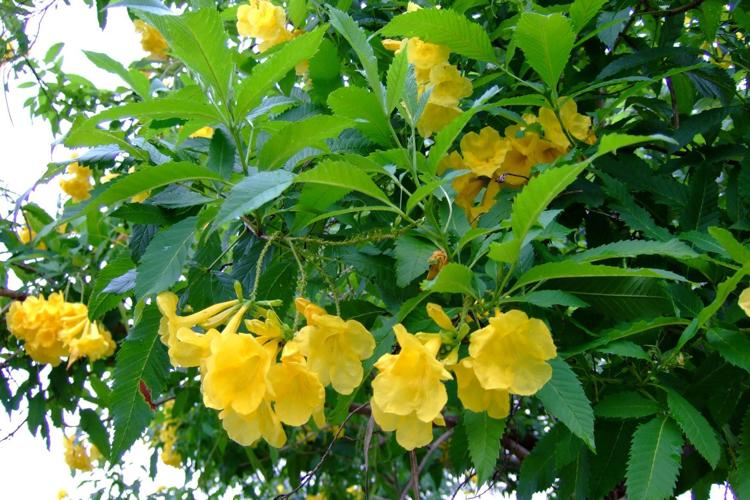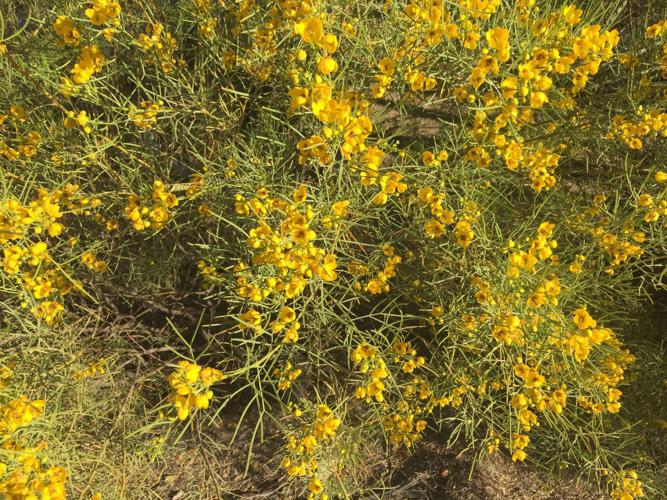Question: I live in Tucson. Alkaline soil, lots of sun, not much rain. I have found contradictory info on fertilizing Tecomas. Local websites either say “responds well to regular fertilizer,” “fertilize with ammonium sulfate” or “this plant particularly hates (fertilizer).” Does anyone have a decisive answer from a reliable source?
Answer: Tecoma stans, aka yellow bells, has a reputation as a tough plant that needs little help once established, except for occasional pruning and pest management. Although I couldn’t find any research detailing its exact needs, all plants need water and nutrients.
If you want to have your soil tested by a laboratory, many of them will make fertilizer recommendations based on the results and which plants you are planning to grow. If you would rather experiment without a soil test, I recommend a slow release tree and shrub fertilizer in the spring and also recommend regularly scheduled drip irrigation every two or three weeks unless it is raining.
You can use composted manure or another organic material that has been composted as a slow-release fertilizer. In the end, your plants will help you figure out their needs by how well they appear and grow. For example, plants that begin to have yellow leaves with green veins are often showing a sign of nutrient deficiency. Taking a look at your landscape plants once a week or so to see if problems are occurring is one of the cornerstones of integrated pest management and a great way to catch problems before they get out of hand.
Q: I have three of these in my yard, plus three that came up recently in disturbed ground. What is it?
A: Your plants are called Senna phyllodinea, or desert Senna or silver leaf cassia. It is native to Australia and does well here. It can propagate by seed. The slender silver leaves are a good desert adaptation for reflecting the sun and reducing exposure to it. They can grow into a large shrub of 6 feet by 6 feet if allowed. The fragrant yellow flowers in February are a welcome sight for many.
Q: Some of my snapdragons are covered with dark spots and it seems to be spreading to neighboring plants. What can I do to stop this problem?
A: From examining your plant sample, the problem is a disease called snapdragon rust that is caused by the fungus Puccinia antirrhini. This is a widespread pathogen that has been around since the 1800s. Small, yellow spots on the leaves are the first indication. Unless you are paying close attention, you won’t notice the yellow spots until they mature into chocolate-brown pustules. The spores that emerge from these pustules are spread by wind mostly but also possibly by rain and insects. The infection and incubation of these spores occurs best when temperatures are between 50 and 75 degrees, and that is what we have been experiencing in recent weeks.
Once temperatures exceed 90 degrees or so, the spores cannot survive. Infested plants can be removed and destroyed to reduce the immediate source of spores. There are also fungicides available to manage the rust if removing the plants isn’t in the plan. Look for products labeled for managing rust on landscape plants. Rust-resistant varieties of snapdragons are available. Planting them with space between to allow for air circulation is helpful, as is making sure to use drip irrigation rather than overhead sprinklers.
Q: I have an area about 15 feet by 12 feet that is bordered on two sides by sidewalk on the south side of my house. I have an 8-year-old thornless mesquite tree planted in this area. I am worried about the possibility of the roots damaging the sidewalks. Should I remove this tree? If I do, what type of tree would you recommend for that size area that would not harm the sidewalks? This area is next to my front patio and I would like to have some shade for it.
A: Thornless mesquite trees are a South American hybrid also known as the Chilean mesquite. The mature size of this tree is approximately 30 feet by 30 feet and that is only the above-ground size. The roots may spread twice as far, so your sidewalk is in jeopardy.
Small trees that could fit this space include kidneywood, Texas mountain laurel, Arizona rosewood, little leaf ash, and leather-leaf acacia. These may not give the shade you desire.
A few slightly larger trees that might fit are Texas ebony, palo blanco, and cascalote. I am sure there are others, so it would be good to visit our local nurseries to see what they have available.





